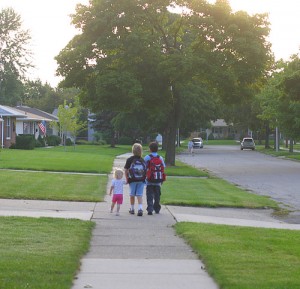The Vanishing Walk to School

Since the late 1960s, the share of U.S. kids and teens who are overweight has more than tripled. Why? I personally find Ronald McDonald kind of sinister, but it’s possible that Happy Meals might not deserve all the blame. In fact, Noreen McDonald—no relation to Ronald—of the University of North Carolina at Chapel Hill has analyzed a trend that might be contributing to the alarming rise in childhood obesity: kids today aren’t walking or biking to school like they used to.
In 1969, the National Household Travel Survey found that roughly 41% of school-age children/teens got to school by “active travel” (i.e. walking and biking, though mostly walking, which then and now is more than 10 times more prevalent than biking).
In 2001 the walk/bike share was down to roughly 13%, a pretty spectacular drop. For elementary school children the change was even more stark. Today, even students who live within one mile of school have a less than 50% chance of walking; about 86% of similarly situated students walked in 1969.
This tectonic shift in kids’ travel behavior raises a number of questions. The first is whether, unless you are an unemployed crossing guard, you should care.
John R. Sirard and Megan E. Slater have conducted a nice review of the evidence on this topic. First off, they address the fundamental issue of whether walking and biking to school does indeed lead to a more active overall lifestyle. Given that active travel to school means on average about 20 minutes of physical exertion per day, it would seem self-evident that walkers and bikers get more exercise. However, it is possible that those who walk and bike compensate by getting less exercise at other times of the day.
A number of studies in the U.S. and abroad have addressed this question, and the preponderance of the evidence does suggest that those who walk and bike are more active in total. In fact, there is tenuous evidence that those who walk and bike might actually be more active the rest of the day, though this does not prove that walking and biking to school actually causes kids to engage more in other types of exercise.
On the other hand, the next step in the causal chain—connecting active travel to school to overall physical fitness—is far more tenuous. Studies have found very limited and contradictory evidence about whether kids and teens who walk and bike are less overweight than their peers. Studies looking at other aspects of fitness are similarly inconclusive. Overall, to date the evidence does not support the claim that those who walk and bike to school are in any better shape.
If there is no proven link between fitness and active travel to school, should we just resign ourselves to the fact that kids’ lives have changed? Perhaps if we really want them to experience the thrill of rolling down the street on a bike we should just come out with a PlayStation 3 “Biking to School” game, which would probably get a lot more takers than actual bikes do.
However, there are probably other benefits from walking and biking. Active travel to school has been replaced not by school bus riding but by travel in private cars, the share of which has risen from less than 20% in 1969 to about 55% today. All those cars are burning fuel and creating emissions, including in the immediate vicinity of schools, suggesting that having kids get to school on foot or by bike would benefit the environment.
Plus, walking and biking just seem right. I walked and/or biked to school for most of my school-aged years, and it somehow strikes me as sad that kids today do not.
I swore I’d never be one of those people who prattle on about just how much better things were when they were a kid. However, on the eminently reasonable assumption that everybody would be much better off if they made exactly the same choices I do, I’m going to accept the intuitive notion that more walking and biking would be a good thing.
So the next question is, what factors cause kids to walk and bike? And how can we use that information to promote active travel? More next time.

Comments